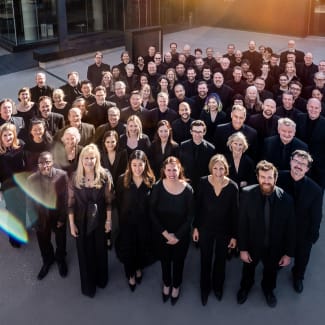
CONCERT ACTIVITIES
Music for a Better World
Composers and song writers use their music to respond to the world around them, including both positive experiences and issues we face as a society. They can use their music to make a statement, advocating for change and spreading awareness about the causes close to their hearts. Featuring music across the centuries including Beethoven’s Overture to Leonore, Carlos Simon’s The Block and powerful songs by South African musical ensemble 29:11 International Exchange, this program is all about music that can change the world and ourselves.
Guide to the Orchestra
See instruments in action, as demonstrated by Minnesota Orchestra musicians.
Concert Program
Beethoven - Leonore Overture No. 3
Watkins - Once Upon a Time, from Five Movements in Color
Huỳnh - Blood is thicker than water, from Gia Đình
Simon - The Block
29:11 International Exchange - Die Ghoema, Still Love and Shosholoza
About the Composers
Ludwig van Beethoven (1770-1827) was a German composer and pianist and is one of the world’s most well-known composers, known for his beautiful symphonies. With his earlier works using composition techniques consistent with the Classical era and his later works aligned with music of the Romantic era, he spanned the transition between the two musical periods. Beethoven was born in Bonn, Germany and began playing piano and composing at an early age with his father, Johann van Beethoven, as his teacher. At age 21 he moved to Vienna, Austria and studied composition with Franz Joseph Haydn and was known around the city as a virtuoso pianist. Beethoven began gradually losing his hearing around 1798, resulting in almost full deafness by 1812. Despite this, Beethoven continued to compose music up until 1826, just one year before his death.
He began writing his only opera, Leonore, in 1804 and the opera premiered in Vienna in 1805. Beethoven revised the music of Leonore several times and re-wrote its overture four times before the opera’s final version premiered in 1814 with an updated libretto; it was at this premiere that the opera and libretto’s title was changed to Fidelio.
The story of this opera is about a woman named Leonore who disguises herself as a prison guard named Fidelio to rescue her husband, Florestan from being put to death in a political prison, in which he is being wrongfully imprisoned by a politician named Don Pizarro. Leonore in disguise is hired to serve as the assistant to the jailer and finds her husband in his cell. Meanwhile, Pizarro gets word of an upcoming inspection of the prison by a minister from the capital. Since he knows that the presence of the illegally imprisoned Florestan will not look good, Pizarro decides that he will kill Florestan before the inspection. At this moment, Leonore reveals her true identity as the minister is arriving for the inspection. With this scene playing out in front of him, the minister takes Don Pizarro to prison and Florestan is free.
Mary D. Watkins (b. 1939) is an American composer and pianist and a native of Denver, Colorado. Watkins is known both for jazz and classical music. She graduated from Howard University in 1972 and began performing with jazz ensembles in Washington, D.C. shortly after. She has released several full-length albums, composed commissioned works for many jazz ensembles, written film scores, and is the recipient of countless awards and grants.
Five Movements in Color features five distinct movements that move chronologically through time. Watkins describes this piece as “a statement about the African American experience” and an “epochal painting” that moves chronologically through five movements. The first movement begins in West Africa, featuring various musical styles and genres from the African diaspora and drumming. As the movements go on, the tone of the music moves from serene to grief to chaos and anxiousness and depicts peace, loss, and a complicated contemporary experience.
Oswald Huỳnh is a Vietnamese American composer whose music navigates Vietnamese aesthetics and tradition, language and translation, and the relationship between heritage and identity. His work is characterized by intricate contrasts of timbre and interweaving textures that are rooted in narrative, culture, and memory. Huỳnh has collaborated with artists like the St. Louis Symphony Orchestra, Alarm Will Sound, American Composers Orchestra, Akropolis Reed Quintet, and Tacet(i) Ensemble. He has received honors from Luigi Nono International Composition Prize, New England Philharmonic, Illinois Philharmonic Orchestra, and Musiqa. Huỳnh holds a BA from Lewis & Clark College and MM from University of Missouri.
In Huỳnh’s words: Gia Đình, meaning “family” in Vietnamese, is an exploration of intergenerational trauma, cultural inheritance, and what is lost between eras. Specifically, I am focusing on the greater Vietnamese diaspora and the Vietnamese boat people, who traveled across the ocean in makeshift boats in search of a future for their families. Many of my own family members were a part of this generation, and only within recent years have they chosen to share their stories with me. Each movement acts as a musical portrait of the various aspects and roots of intergenerational trauma and is titled with a Vietnamese proverb that describes the value of family and the perceived relationship between parent and child in Vietnamese culture.
The final movement, "Blood is Thicker Than Water," (Một giọt máu đào hơn ao nước lã) examines migration, displacement, and assimilation as forms of trauma. In addition to what is passed on to the next generation, this movement also explores what is lost. Language, culture, and history can all be lost within a single generation as a result of displacement. This is represented musically by two extremely contrasting themes: a slow, lyrical melody inspired by Vietnamese folk melodies and a fractured, unrelenting section that cycles through the entire orchestra. I bounce between the two themes until the music melts into a coda that recalls the first movement.
Carlos Simon (b. 1986) is an American composer and grew up in Atlanta, Georgia. He attended Morehouse College in Atlanta before earning his Master’s Degree at Georgia State University and his Doctorate Degree from the University of Michigan. His music ranges from concert music to film scores with influences of jazz, gospel, and neo-romantic styles. Simon is currently the Composer-in-Residence for the John F. Kennedy Center for the Performing Arts, the inaugural Boston Symphony Orchestra Composer Chair, and was nominated for a 2023 Grammy Award for his album Requiem for the Enslaved.
In Simon’s own words: "The Block” is a short orchestral study based on the late visual art of Romare Bearden. Most of Bearden’s work reflects African American culture in urban cities as well as the rural American south. Although Bearden was born in Charlotte, NC, he spent his most of his life in Harlem, New York. With its vibrant artistic community, this piece aims to highlight the rich energy and joyous sceneries that Harlem expressed as it was the hotbed for African American culture.
“The Block” is comprised of six paintings that highlight different buildings (church, barbershop, nightclub, etc.) in Harlem on one block. Bearden’s paintings incorporate various mediums including watercolors, graphite, and metallic papers. In the same way, this musical piece explores various musical textures which highlight the vibrant scenery and energy that a block on Harlem or any urban city exhibits.
29:11 International Exchange is a musical ensemble based in South Africa and the United States. Its mission is to facilitate hope and reconciliation through musical performance and cross-cultural collaboration, and artist development. 29:11 provides valuable professional experience to all members of the ensemble. The group produces, performs, and records music across a wide range of genres. Repertoire features original works, Gospel favorites, remixed rhymes, and pop covers.
29:11’s universal message is centered around the ancient African concept of Ubuntu. Ubuntu roughly translates to “humanity to others”, meaning recognition that a person is who they are because of others. Ubuntu means recognizing that everyone is worthy of understanding and love, and that we can use compassion to heal and transcend barriers that divide us because we are strongest together. They use music in a variety of ways to inspire and cultivate Ubuntu, one group at a time.
Sing a Song with 29:11 at Orchestra Hall!
When you come to Orchestra Hall in February, you will have the opportunity to sing Shosholoza with 29:11 and the Minnesota Orchestra! In this video, Brendon Adams, Artistic Director of 29:11, will guide you through the song so you are ready to sing at Orchestra Hall.

TEACHER ACTIVITIES: MUSIC FOR A BETTER WORLD
Explore our concert guide designed for use in the classroom—including activities, flashcards, and more.
Artists

The Grammy Award-winning Minnesota Orchestra, now in its second century, ranks among America’s top symphonic ensembles, with a distinguished history of acclaimed performances in its home state and around the world; award-winning recordings, broadcasts and educational engagement programs; and a commitment to intentionally build concert programs to feature more works by composers of color, exploring music both contemporary and historic. This past fall, Danish conductor Thomas Søndergård began his tenure as music director.

American conductor Kyle Dickson has built a reputation as an inspiring and compelling presence on the podium. In 2023 he was named the assistant conductor for the Memphis Symphony Orchestra and music director of the Memphis Youth Symphony Program. The recipient of the 2021 Grant Park Music Festival Advocate for the Arts Award, the Concert Artists Guild's Richard S. Weinert Award and the Joel Revzen Conducting Fellowship, Dickson recently completed the Salonen Conducting Fellowship with the San Francisco Symphony and the Colburn School under the guidance of Music Director Esa-Pekka Salonen.

29:11 International Exchange is a music ministry based in South Africa and the United States. Its mission is to facilitate hope and reconciliation through musical performance and collaboration, artist development and cross-cultural relationships. By recognizing that each of us is worthy of understanding and love, we can bridge the ideological, racial and socio-economic gaps that divide us, and live together as citizens of the world.

Brian Grandison has worked as an actor, writer, director, professor, and artist in residence in the Twin Cities, around the country and internationally. He was a member of the acting company at the Guthrie Theater and has performed in plays at Mixed Blood, Illusion theater, History Theater, Theater Latte Da, Chanhassen Dinner Theater, Full Circle Theater and most recently at New Dawn Theater.
Sponsored By
Mary Ann Feldman Music Education Fund
CORPORATE & INSTITUTIONAL SPONSORS






